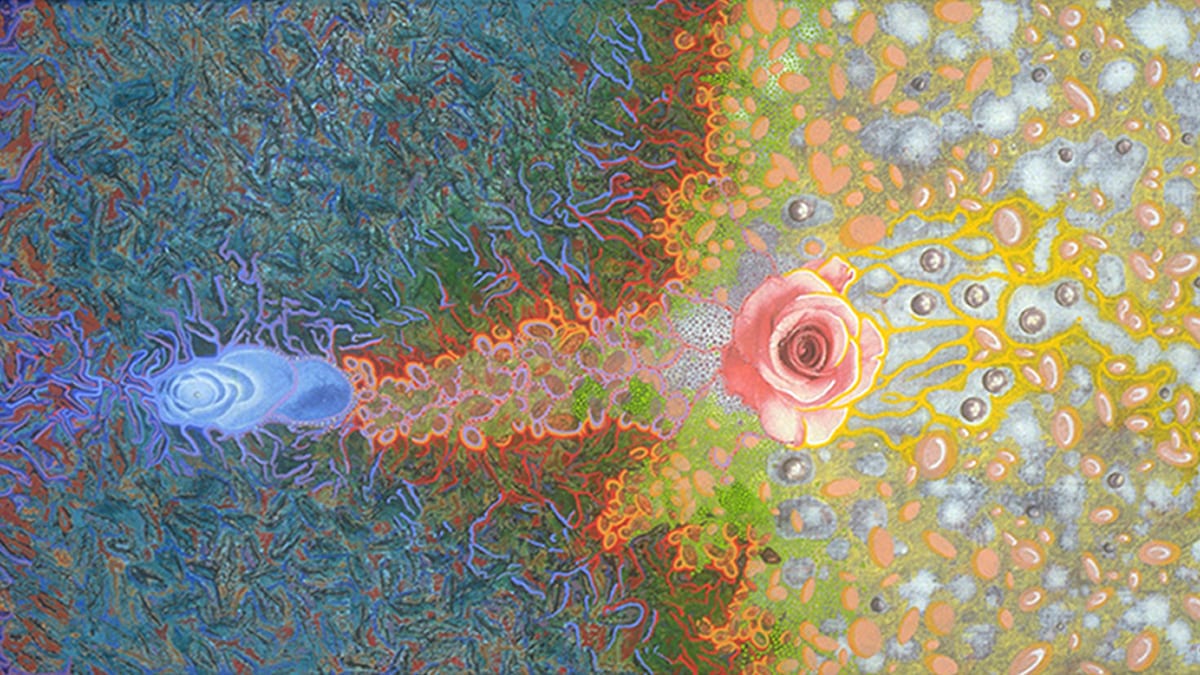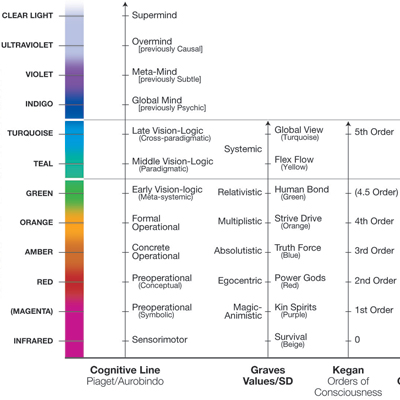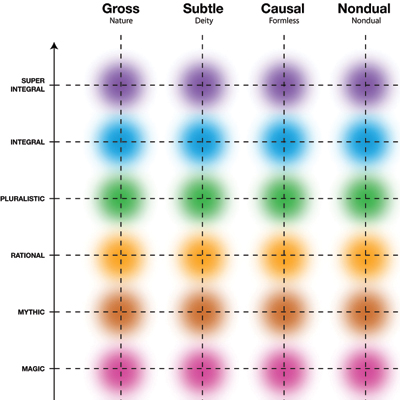The man behind the theory of morphic resonance shares his impulse to explore the evolutionary impulse behind the Kosmos itself. From physics, to chemistry, to biology, to psychology, to spirituality and more, these two pioneers share their understanding of how Spirit is manifesting moment-to-moment in and through the leading edge of consciousness awareness.
Image: Morphic Resonance by Gordon Wood
Einstein proposed and believed in an eternal unchanging physical universe, governed by static laws, not an integrated Kosmos of both interior and exterior dimensions, governed by Kosmic habits. The difference between the two should not be underestimated. Whereas Einstein has famously stated, “God does not play dice,” Rupert and Ken go on to discuss a universe where God does indeed play dice, but in an evolutionary and developmental context—every new game of dice builds upon the billions of games played since the Big Bang, and every new game brings, or builds upon, an aspect of novelty: something the Kosmos has never seen before. The more this novel dimension gets repeated in subsequent “games,” the more likely that we will continue to see it pervade all corners of the universe, in that particular dimension, species, or level of development. One could say it’s the snowball effect writ large, and acting nearly instantaneously across innumerable light-years.
Sounds different from your high school biology class, yes? One reason for this is that Rupert and Ken are exploring how evolution and development occurs in all dimensions of existence—from physics, to chemistry, to biology, to psychology, to spirituality, and more. As Ken would state it, there is a fundamental Eros to the universe, a drive to reach higher, deeper, and further… not to get away from manifestation, but to include and embrace as much of it as possible! Here’s the funny thing about this Kosmos of ours: there are no Platonic Ideals that we should be reaching to understand. There are no eternal Forms. What we—as humans—are given is an evolutionary space in consciousness, a certain degree of depth and complexity that is waiting to be expressed in the universe, and as conscious, sentient beings, we literally determine the form that this space-potential will take as it manifests in the Kosmos. Our intentionality, and our choices, will mold the face of our collective will atop the deep structures presented to us. Nothing is pre-given except for Eros and the possibility of depth and complexity of expression that is on the horizon of our shared consciousness. It’s not so much that humanity is created in God’s own image, but that humanity is God-in-action, and we create the next form of God-in-action based on our own image of what is possible. There is no one responsible beyond ourselves for what comes next. If that happens to be true, it might be good that we all get on the same page, yes?
But that’s another discussion. In a developmental and evolutionary context, getting all of humanity “on the same page” is far more complicated than it might initially appear. However, if you’re reading these words right now, it means you’re interested in the same degree of passionate creativity and responsibility that an Integral View helps clarify and enact. You’re not alone. For a mind that only sees surfaces, one could think that this is a dialogue merely about biology, and a pretty far-out biology at that. But this dialogue is not merely about biology. It’s about the nature of the Kosmos itself. It’s about the mechanisms of evolution, the process that brought you, personally, to where you are right now. What you do from here is up to you: will I look back and understand the Kosmic forces responsible for my existence in this very moment, or will I distract myself with other affairs? It’s not that either choice is good or bad. It’s about the nature of choice itself.
* * *
There’s an old joke about a King who goes to a Wiseperson and asks how it is the Earth doesn’t fall down. The Wiseperson replies, “The Earth is resting on a lion.” “On what, then, is the lion resting?” “The lion is resting on an elephant.” “On what is the…?” “You can stop right there, your majesty. It’s turtles all the way down.”
Turtles all the way down, turtles all the way up. This crucial insight into the nature of evolution reconciles much of the debate that has existed for centuries between atomists, who consider the fundamental parts of the universe as ultimately real, and the wholists, who see reality as a mere echo of the living whole of the universe. Neither argument is wrong, per se, though neither is quite right either. There is no fundamental part, no “bottom floor” which the entire universe can be reduced to in any meaningful way. Nor is there a single universal whole to which all of reality aspires—there are only whole/parts, or holons, spiraling infinitely in both directions. Whole atoms are part of whole molecules, which are part of whole cells, which are part of whole organisms, et cetera, ad infinitum. Even the totality of this present moment becomes a part of the following moment—turtles begetting turtles forever, stretching from the Big Bang to Eternity.
The turtle metaphor is also useful when looking at some of the more fundamental levels of the universe, the magnitudes disclosed by physics and chemistry. “Biology is the study of large organisms,” says Alfred Whitehead, “whereas physics is the study of small organisms.” Whitehead wasn’t being cute or even poetic here, but was suggesting a dramatic reconsideration of the manifest world—namely, that some form of consciousness, subjectivity, or awareness is intrinsic to the universe, on every level. Put simply, if something has an objective form, it has some degree of subjective awareness—even if in the most limited sense imaginable. It’s turtles all the way up and all the way down, and every turtle has both an inside and an outside.
Just as a holonic cosmology of “whole-parts within whole-parts forever” reconciles atomism and wholism, Whitehead’s thesis transcends and includes the very best of subjectivist and objectivist arguments. In a single puff of logic, the “consciousness problem” ceases to be—and no longer can materialists reduce our awareness, memories, loves, and dreams to the epiphenomena of purely physical processes, phantom byproducts of the chemical soup sloshing about between our ears. Nor can idealists continue to drift about in a haze of abstract solipsism, viewing the entire universe as a projection of their own innate perfection, deluded by a strange brew of mysticism and narcissism. Reality cannot be reduced to matter alone, just as it cannot be reduced to consciousness alone—both matter and consciousness are intrinsically built into the architecture of reality. And as matter evolves into more and more complex forms, the deeper the consciousness becomes.
If there is to be any measure of scientific progress at all, it would be the ability to unify two previously irreconcilable arguments, integrating them both into a bigger and better argument. Often they are revealed to be opposite sides of a single coin—a coin which simply cannot be perceived without a more comprehensive perspective. In much the same way that Newton reconciled the laws governing the heavens and the earth, and how Einstein united the laws of matter and energy, this may be one of the most extraordinary contributions Integral theory has to offer the world: a staggering ability to reach across multiple paradigms of thought and pull together so much of the complexity of our universe. In this integral cross-paradigmatic space, we can reconcile the differences between the atomists and the wholists, between the idealists and the materialists, between the mind and the body, and between the spiritual and the scientific.
Rupert and Ken took a careful look at the relationship between matter and consciousness in a single entity (a.k.a. holon or morphic unit) explaining that everything that has a coherent objective form also has a subjective interior. In this section, they continue to tease apart some extremely important distinctions, most notably the difference between individual holons and social holons. This has been another source of confusion for evolutionary thinkers, many of whom are able to easily grasp the holonic sequence of whole/parts, but often make the mistake of stacking social holons on top of individual holons.
For example, one frequently-used model of evolutionary complexity looks like this:
atoms → molecules → cells → organisms → human beings → families → cities → nations → ecosystems → gaia → solar system → gala
To many, this sequence makes immediate intuitive sense, as each piece seems to envelop the previous piece, forming larger and larger magnitudes of existence. But when we take a closer look, we can see that there are in fact two very different types of hierarchies in play—individual hierarchies and social hierarchies—and these two different dimensions of hierarchical growth do not stack on top of each other, but grow alongside each other, as demonstrated here:
-
INDIVIDUAL
atoms
molecules
cells
organisms
human beings -
SOCIAL
galaxies
planets
ecosystems (Gaia)
families
tribes, cities, nations, etc.
As we can see, by simply introducing a collective dimension to our understanding of the universe, we are given a radically different map of our evolutionary origins. Add to that the differentiation of subjective and objective dimensions of existence, each successive wave of evolution yielding more complexity of form and deeper subjective interiority—and at last a truly comprehensive tapestry of evolutionary potential begins to appear—a genuine “theory of everything” that reveals in a single glance the entirety of our evolutionary heritage, helping us all to predict where we are going as a species by more fully understanding where we came from.
This Four-Quadrant diagram helps one look at our Kosmic existence from a meta-perspective, and in a brief glance, we can see “where we’ve come from” and “where we’re going”—or where we might be lucky enough to end up, should we truly apply ourselves to the vision of what humanity could become, in our livetimes, if we really want it.
Integral Resources
Here you will find charts and diagrams that may be useful for this discussion (click to enlarge).
About Rupert Sheldrake
Rupert Sheldrake is a British biologist and author who has developed the theory of morphic resonance, incorporating the insights of early twentieth century morphogenetic fields and extending the understanding of biological "fields" to entire species.
About Ken Wilber
Ken Wilber is a preeminent scholar of the Integral stage of human development. He is an internationally acknowledged leader, founder of Integral Institute, and co-founder of Integral Life. Ken is the originator of arguably the first truly comprehensive or integrative world philosophy, aptly named “Integral Theory”.




